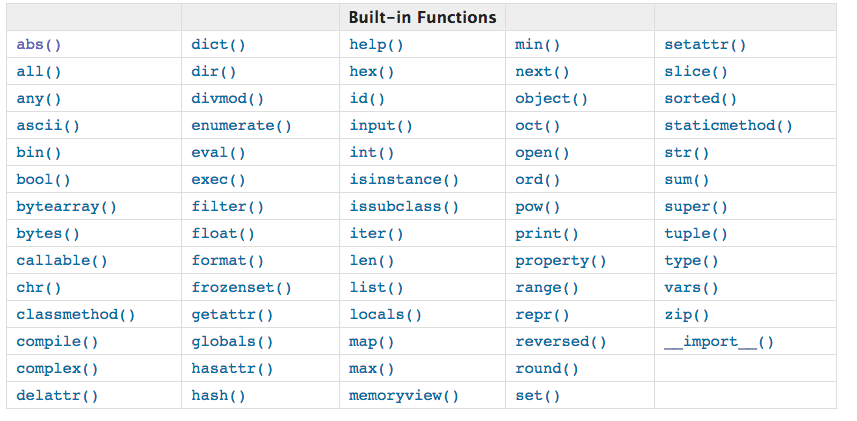内置函数:

1 # all() 如果可迭代对象里面都为真则为True,如果有一个为假就为False 2 #非0为真,0为假。 3 a = all([0,5]) 4 print(a) 5 6 # any() 如果可迭代对象里面都为假则为False,如果其中一个为真就为True 7 a1 = any([0,6]) 8 print(a1) 9 10 #ascii() 将列表变为字符串的形式。 11 a = ascii([1,2,"开外挂"]) 12 print(type(a)) 13 print([a]) 14 15 #bin() 十进制转二进制 16 print(bin(25)) 17 18 #bool() 判断真假 19 print(bool()) #False 20 print(bool(0)) #False 21 print(bool(1)) #True 22 print(bool(2)) #True 23 print(bool([])) #False 24 print(bool([1])) #True 25 26 27 #bytearray() 二进制数组 将字符串变为数组的格式,可以修改。 28 a = bytes("abcde",encoding="utf-8") 29 print(a.capitalize(),a) 30 print(type(a)) 31 #从上面可以看出字符串是不能修改,只能创建一个新的。 32 33 34 #下面通过bytearray() 将字符串变为数组的格式让二进制可以修改。 35 b = bytearray("abcde",encoding="utf-8") 36 print(type(b)) 37 print(b) 38 print(b[1]) 39 b[1] = 50 40 print(b) 41 42 #callable() 判断是否可以调用,后面可以加上()的就可以调用 可以调用的有函数和类 43 def test():pass 44 print(callable(test)) #返回True,函数可以调用 45 print(callable([])) #返回False,列表不可调用 46 47 48 #chr() ascii码表 数字--->字符 49 print(chr(97)) #返回 a, 50 51 52 #ord() ascii码表 字符---->数字 53 print(ord("a")) 54 55 #classmethod() 56 57 58 #compile() 用于把代码进行编译的过程, 解释:将字符串转换为命令执行 59 code = "for i in range(10):print(i)" 60 c = compile(code,"","exec") 61 exec(c) 62 63 # 或者直接使用exec(code)实现将字符串转换为命令执行。 64 exec(code) 65 code1 = "1+3/2*6" 66 c1 = compile(code1,"","eval") 67 print(eval(c1)) 68 69 #delattr() 以后讲 70 71 72 #dict() 生成字典 73 # 两种字典生成方式: 74 # 1、dict() 75 # 2、{} 76 77 78 # dir() 查看 使用方法即命令。 79 a = {} 80 print(dir(a)) 81 82 # divmod() #返回两个数相除的商和余数。 83 print(divmod(5,2)) #返回(2,1) 84 85 86 # enumerate() 遍历列表 87 list1=["这","是","一个","测试"] 88 for index,item in enumerate(list1,1): 89 print(index,item) 90 91 #eval() 将字符串变为字典 将加减乘除算法转换为字典。 92 93 94 #exec() 将字符串转换为字典执行, 95 96 97 #filter() 98 def sayhi(n): 99 print(n) 100 sayhi(3) 101 102 #匿名函数lambda实现上面sayhi函数的功能。 匿名函数只能实现三元运算。 103 calc = lambda n:print(n) 104 calc(5) 105 106 #在0-10之间将大于5的过滤出来。 107 res = filter(lambda n:n>5,range(10)) 108 for i in res: 109 print(i) 110 111 #map() 将传入的每个值按照一种方式处理。 现在按n*2处理 112 res1 = map(lambda n:n*2,range(10)) # 等同于 i*2 for i in range(10) 113 for i in res1: 114 print(i) 115 116 #reduce() 需要调用functools工具,相加或者相乘等。 117 #利用reduce,实现0+1+2...+10 118 import functools 119 res2 = functools.reduce(lambda x,y:x+y,range(10)) 120 print(res2) #返回45 从0加到10,依次相加 121 122 123 #利用reduce,将从1一直乘到10. 1x2x3...x10 124 res3 = functools.reduce(lambda x,y:x*y,range(1,10)) 125 print(res3) 126 127 # float() 转换为浮点数 128 print(float(10)) 129 130 # format() 131 132 133 # frozenset() 不可变集合 a集合就有pop功能,a1就没有pop功能了。 134 a = set([1,2,444,44,55,44,12,4]) 135 a.pop() 136 a1 = frozenset([1,2,444,44,55,44,12,4]) 137 138 #getattr() 面向对象的时候讲 139 140 141 # globals() 返回当前程序(内置函数1)的全局变量,返回的是字典,key:values 142 # print(globals()) 143 144 145 # hasattr() 146 # print(hasattr(alex)) 147 print(hash("alex")) 148 149 # hex() 将十进制转换为十六进制 150 print(hex(16)) 151 152 # id() 返回内存地址 153 print(id(10)) 154 155 # input() 156 157 158 # int() 159 160 161 # isinstance() 162 163 164 # issubclass() 是不是一个子类 165 166 167 # iter() 迭代器 168 169 170 # len() 长度 171 172 173 # list() 列表 174 175 176 # locals() 显示局部变量 177 def test(): 178 local_var = 333 179 # print(globals()) 180 print(locals()) 181 test() 182 183 # max() 返回列表里面的最大值 184 185 186 # min() 返回列表里面的最小值 187 188 189 # next() 迭代器两个下划线的next __next 190 191 192 # object() 对象 ,python中一切皆对象。 193 194 195 # oct() 转换为八进制 196 print(oct(8)) 197 198 # pow() 前面数的后面次方 199 print(pow(2,8)) #2的8次方。 200 201 202 # property() 以后讲 203 204 # range() 范围 205 206 # repr() 用字符串表示对象。 207 208 # reversed() 反转 209 210 # round() 保留有效数字 211 print(round(3.14159,2)) #保留两位有效数字 212 213 # setattr() 后面讲 214 215 # slice() 切片 可以忘记 216 217 # sorted() 字典排序。 218 a = {6:2,8:0,1:4,-5:6,99:11,4:22} 219 print(sorted(a.items())) #默认按照key来排序 220 print(sorted(a.items(),key=lambda x:x[1])) #按照value来排序。 221 print(a) 222 223 224 # staticmethod() 后面讲 225 226 # str( ) 227 228 # sum() 列表求和 229 230 # super() 以后讲 231 232 # tuple() 元组 233 234 # type() 数据类型 235 236 # vars() 用不到 237 238 # zip() 列表合并 239 a = [1,2,3,4,5,6] 240 b = ["a","b","c","d"] 241 c = zip(a,b) 242 for i in c: 243 print(i) 244 # __import__() 调用一个字符串 后面会用到 245 __import__("def")



 posted on
posted on
